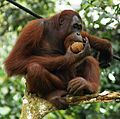This article needs to be updated.(June 2020) |

The World's 25 Most Endangered Primates is a list of highly endangered primate species selected and published by the International Union for Conservation of Nature (IUCN) Species Survival Commission (SSC) Primate Specialist Group (PSG), the International Primatological Society (IPS), Global Wildlife Conservation (GWC), and Bristol Zoological Society (BZS). [1] The IUCN/SSC PSG worked with Conservation International (CI) to start the list in 2000, but in 2002, during the 19th Congress of the International Primatological Society, primatologists reviewed and debated the list, resulting in the 2002–2004 revision and the endorsement of the IPS. The publication was a joint project between the three conservation organizations until the 2012–2014 list when BZS was added as a publisher. [2] The 2018–2020 list was the first time Conservation International was not among the publishers, replaced instead by GWC. The list has been revised every two years following the biannual Congress of the IPS. [1] Starting with the 2004–2006 report, the title changed to "Primates in Peril: The World's 25 Most Endangered Primates". [3] That same year, the list began to provide information about each species, including their conservation status and the threats they face in the wild. [4] The species text is written in collaboration with experts from the field, with 60 people contributing to the 2006–2008 report [5] and 85 people contributing to the 2008–2010 report. [4] The 2004–2006 and 2006–2008 reports were published in the IUCN/SSC PSG journal Primate Conservation , [3] [6] , since then they have been published as independent publications. [4] [7] [2] [8] [9] [1]
Contents
The 25 species on the 2018–2020 list are distributed between 32 countries. The country with the most species on the list is Madagascar with five species, Indonesia, Brazil, Ghana, and Côte d'Ivoire each have three. The list is broken into four distinct regions: the island of Madagascar, the continent of Africa, the continent of Asia including the islands of Indonesia, and the Neotropics (Central and South America). [1]
The purpose of the list, according to Russell Mittermeier, the president of CI, is "to highlight those [primate species] that are most at risk, to attract the attention of the public, to stimulate national governments to do more, and especially to find the resources to implement desperately needed conservation measures." [10] Species are selected for the list based on two primary reasons: extremely small population sizes and very rapid drops in numbers. These reasons are heavily influenced by habitat loss and hunting, the two greatest threats primates face. More specifically, threats listed in the report include deforestation due to slash-and-burn agriculture, clearing for pasture or farmland, charcoal production, firewood production, illegal logging, selective logging, mining, land development, and cash crop production; forest fragmentation; small population sizes; live capture for the exotic pet trade; and hunting for bushmeat and traditional medicine. [4] Twelve species were dropped for the 2018–2020 list, Mittermeier notes this was not because their situation has improved but instead to focus attention on other species that are also have "bleak prospects for their survival. [1]



















































